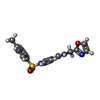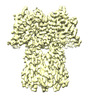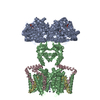+ Open data
Open data
- Basic information
Basic information
| Entry |  | |||||||||
|---|---|---|---|---|---|---|---|---|---|---|
| Title | Ligand-bound human Kv3.1 cryo-EM structure (Lu AG00563) | |||||||||
 Map data Map data | ||||||||||
 Sample Sample |
| |||||||||
 Keywords Keywords | Potassium ion channel / voltage gated / drug target / MEMBRANE PROTEIN | |||||||||
| Function / homology |  Function and homology information Function and homology informationresponse to nerve growth factor / globus pallidus development / response to fibroblast growth factor / response to potassium ion / corpus callosum development / response to auditory stimulus / voltage-gated monoatomic ion channel activity involved in regulation of presynaptic membrane potential / delayed rectifier potassium channel activity / Voltage gated Potassium channels / positive regulation of potassium ion transmembrane transport ...response to nerve growth factor / globus pallidus development / response to fibroblast growth factor / response to potassium ion / corpus callosum development / response to auditory stimulus / voltage-gated monoatomic ion channel activity involved in regulation of presynaptic membrane potential / delayed rectifier potassium channel activity / Voltage gated Potassium channels / positive regulation of potassium ion transmembrane transport / response to light intensity / optic nerve development / neuronal cell body membrane / response to amine / action potential / axolemma / kinesin binding / voltage-gated potassium channel activity / axon terminus / voltage-gated potassium channel complex / potassium ion transmembrane transport / dendrite membrane / calyx of Held / cerebellum development / protein tetramerization / protein homooligomerization / potassium ion transport / response to toxic substance / cellular response to xenobiotic stimulus / presynaptic membrane / transmembrane transporter binding / postsynaptic membrane / cell surface / plasma membrane Similarity search - Function | |||||||||
| Biological species |  Homo sapiens (human) Homo sapiens (human) | |||||||||
| Method | single particle reconstruction / cryo EM / Resolution: 3.03 Å | |||||||||
 Authors Authors | Botte M / Huber S / Bucher D / Klint JK / Rodriguez D / Tagmose L / Chami M / Cheng R / Hennig M / Abdul Rhaman W | |||||||||
| Funding support | 1 items
| |||||||||
 Citation Citation |  Journal: PNAS Nexus / Year: 2022 Journal: PNAS Nexus / Year: 2022Title: Apo and ligand-bound high resolution Cryo-EM structures of the human Kv3.1 channel reveal a novel binding site for positive modulators. Authors: Mathieu Botte / Sophie Huber / Denis Bucher / Julie K Klint / David Rodríguez / Lena Tagmose / Mohamed Chami / Robert Cheng / Michael Hennig / Wassim Abdul Rahman /   Abstract: Kv3 ion-channels constitute a class of functionally distinct voltage-gated ion channels characterized by their ability to fire at a high frequency. Several disease relevant mutants, together with ...Kv3 ion-channels constitute a class of functionally distinct voltage-gated ion channels characterized by their ability to fire at a high frequency. Several disease relevant mutants, together with biological data, suggest the importance of this class of ion channels as drug targets for CNS disorders, and several drug discovery efforts have been reported. Despite the increasing interest for this class of ion channels, no structure of a Kv3 channel has been reported yet. We have determined the cryo-EM structure of Kv3.1 at 2.6 Å resolution using full-length wild type protein. When compared to known structures for potassium channels from other classes, a novel domain organization is observed with the cytoplasmic T1 domain, containing a well-resolved Zinc site and displaying a rotation by 35°. This suggests a distinct cytoplasmic regulation mechanism for the Kv3.1 channel. A high resolution structure was obtained for Kv3.1 in complex with a novel positive modulator Lu AG00563. The structure reveals a novel ligand binding site for the Kv class of ion channels located between the voltage sensory domain and the channel pore, a region which constitutes a hotspot for disease causing mutations. The discovery of a novel binding site for a positive modulator of a voltage-gated potassium channel could shed light on the mechanism of action for these small molecule potentiators. This finding could enable structure-based drug design on these targets with high therapeutic potential for the treatment of multiple CNS disorders. | |||||||||
| History |
|
- Structure visualization
Structure visualization
| Supplemental images |
|---|
- Downloads & links
Downloads & links
-EMDB archive
| Map data |  emd_13605.map.gz emd_13605.map.gz | 1.4 MB |  EMDB map data format EMDB map data format | |
|---|---|---|---|---|
| Header (meta data) |  emd-13605-v30.xml emd-13605-v30.xml emd-13605.xml emd-13605.xml | 11.3 KB 11.3 KB | Display Display |  EMDB header EMDB header |
| Images |  emd_13605.png emd_13605.png | 146.7 KB | ||
| Filedesc metadata |  emd-13605.cif.gz emd-13605.cif.gz | 5.5 KB | ||
| Archive directory |  http://ftp.pdbj.org/pub/emdb/structures/EMD-13605 http://ftp.pdbj.org/pub/emdb/structures/EMD-13605 ftp://ftp.pdbj.org/pub/emdb/structures/EMD-13605 ftp://ftp.pdbj.org/pub/emdb/structures/EMD-13605 | HTTPS FTP |
-Validation report
| Summary document |  emd_13605_validation.pdf.gz emd_13605_validation.pdf.gz | 346.9 KB | Display |  EMDB validaton report EMDB validaton report |
|---|---|---|---|---|
| Full document |  emd_13605_full_validation.pdf.gz emd_13605_full_validation.pdf.gz | 346.5 KB | Display | |
| Data in XML |  emd_13605_validation.xml.gz emd_13605_validation.xml.gz | 6.8 KB | Display | |
| Data in CIF |  emd_13605_validation.cif.gz emd_13605_validation.cif.gz | 7.8 KB | Display | |
| Arichive directory |  https://ftp.pdbj.org/pub/emdb/validation_reports/EMD-13605 https://ftp.pdbj.org/pub/emdb/validation_reports/EMD-13605 ftp://ftp.pdbj.org/pub/emdb/validation_reports/EMD-13605 ftp://ftp.pdbj.org/pub/emdb/validation_reports/EMD-13605 | HTTPS FTP |
-Related structure data
| Related structure data |  7pquMC  7pqtC C: citing same article ( M: atomic model generated by this map |
|---|---|
| Similar structure data | Similarity search - Function & homology  F&H Search F&H Search |
- Links
Links
| EMDB pages |  EMDB (EBI/PDBe) / EMDB (EBI/PDBe) /  EMDataResource EMDataResource |
|---|---|
| Related items in Molecule of the Month |
- Map
Map
| File |  Download / File: emd_13605.map.gz / Format: CCP4 / Size: 149.9 MB / Type: IMAGE STORED AS FLOATING POINT NUMBER (4 BYTES) Download / File: emd_13605.map.gz / Format: CCP4 / Size: 149.9 MB / Type: IMAGE STORED AS FLOATING POINT NUMBER (4 BYTES) | ||||||||||||||||||||||||||||||||||||
|---|---|---|---|---|---|---|---|---|---|---|---|---|---|---|---|---|---|---|---|---|---|---|---|---|---|---|---|---|---|---|---|---|---|---|---|---|---|
| Projections & slices | Image control
Images are generated by Spider. | ||||||||||||||||||||||||||||||||||||
| Voxel size | X=Y=Z: 0.82 Å | ||||||||||||||||||||||||||||||||||||
| Density |
| ||||||||||||||||||||||||||||||||||||
| Symmetry | Space group: 1 | ||||||||||||||||||||||||||||||||||||
| Details | EMDB XML:
|
-Supplemental data
- Sample components
Sample components
-Entire : Detergent solubilized tetramer of human Kv3.1 potassium ion chann...
| Entire | Name: Detergent solubilized tetramer of human Kv3.1 potassium ion channel in complex with Lu AG00563 |
|---|---|
| Components |
|
-Supramolecule #1: Detergent solubilized tetramer of human Kv3.1 potassium ion chann...
| Supramolecule | Name: Detergent solubilized tetramer of human Kv3.1 potassium ion channel in complex with Lu AG00563 type: complex / ID: 1 / Parent: 0 / Macromolecule list: #1 |
|---|---|
| Source (natural) | Organism:  Homo sapiens (human) Homo sapiens (human) |
-Macromolecule #1: Potassium voltage-gated channel subfamily C member 1
| Macromolecule | Name: Potassium voltage-gated channel subfamily C member 1 / type: protein_or_peptide / ID: 1 / Number of copies: 4 / Enantiomer: LEVO |
|---|---|
| Source (natural) | Organism:  Homo sapiens (human) Homo sapiens (human) |
| Molecular weight | Theoretical: 58.88318 KDa |
| Recombinant expression | Organism:  Homo sapiens (human) Homo sapiens (human) |
| Sequence | String: MGQGDESERI VINVGGTRHQ TYRSTLRTLP GTRLAWLAEP DAHSHFDYDP RADEFFFDRH PGVFAHILNY YRTGKLHCPA DVCGPLYEE ELAFWGIDET DVEPCCWMTY RQHRDAEEAL DSFGGAPLDN SADDADADGP GDSGDGEDEL EMTKRLALSD S PDGRPGGF ...String: MGQGDESERI VINVGGTRHQ TYRSTLRTLP GTRLAWLAEP DAHSHFDYDP RADEFFFDRH PGVFAHILNY YRTGKLHCPA DVCGPLYEE ELAFWGIDET DVEPCCWMTY RQHRDAEEAL DSFGGAPLDN SADDADADGP GDSGDGEDEL EMTKRLALSD S PDGRPGGF WRRWQPRIWA LFEDPYSSRY ARYVAFASLF FILVSITTFC LETHERFNPI VNKTEIENVR NGTQVRYYRE AE TEAFLTY IEGVCVVWFT FEFLMRVIFC PNKVEFIKNS LNIIDFVAIL PFYLEVGLSG LSSKAAKDVL GFLRVVRFVR ILR IFKLTR HFVGLRVLGH TLRASTNEFL LLIIFLALGV LIFATMIYYA ERIGAQPNDP SASEHTHFKN IPIGFWWAVV TMTT LGYGD MYPQTWSGML VGALCALAGV LTIAMPVPVI VNNFGMYYSL AMAKQKLPKK KKKHIPRPPQ LGSPNYCKSV VNSPH HSTQ SDTCPLAQEE ILEINRAGRK PLRGMSIGSL EVLFQ UniProtKB: Voltage-gated potassium channel KCNC1 |
-Macromolecule #2: 1-(4-methylphenyl)sulfonyl-N-(1,3-oxazol-2-ylmethyl)pyrrole-3-car...
| Macromolecule | Name: 1-(4-methylphenyl)sulfonyl-N-(1,3-oxazol-2-ylmethyl)pyrrole-3-carboxamide type: ligand / ID: 2 / Number of copies: 4 / Formula: 805 |
|---|---|
| Molecular weight | Theoretical: 345.373 Da |
| Chemical component information |  ChemComp-805: |
-Macromolecule #3: POTASSIUM ION
| Macromolecule | Name: POTASSIUM ION / type: ligand / ID: 3 / Number of copies: 4 / Formula: K |
|---|---|
| Molecular weight | Theoretical: 39.098 Da |
-Macromolecule #4: water
| Macromolecule | Name: water / type: ligand / ID: 4 / Number of copies: 14 / Formula: HOH |
|---|---|
| Molecular weight | Theoretical: 18.015 Da |
| Chemical component information |  ChemComp-HOH: |
-Experimental details
-Structure determination
| Method | cryo EM |
|---|---|
 Processing Processing | single particle reconstruction |
| Aggregation state | particle |
- Sample preparation
Sample preparation
| Buffer | pH: 7.5 |
|---|---|
| Vitrification | Cryogen name: ETHANE |
- Electron microscopy
Electron microscopy
| Microscope | FEI TITAN KRIOS |
|---|---|
| Image recording | Film or detector model: GATAN K2 SUMMIT (4k x 4k) / Average electron dose: 70.0 e/Å2 |
| Electron beam | Acceleration voltage: 300 kV / Electron source:  FIELD EMISSION GUN FIELD EMISSION GUN |
| Electron optics | Illumination mode: OTHER / Imaging mode: BRIGHT FIELD / Nominal defocus max: 2.5 µm / Nominal defocus min: 0.8 µm |
| Experimental equipment |  Model: Titan Krios / Image courtesy: FEI Company |
- Image processing
Image processing
| Startup model | Type of model: PDB ENTRY PDB model - PDB ID: |
|---|---|
| Final reconstruction | Resolution.type: BY AUTHOR / Resolution: 3.03 Å / Resolution method: FSC 0.143 CUT-OFF / Number images used: 219839 |
| Initial angle assignment | Type: MAXIMUM LIKELIHOOD |
| Final angle assignment | Type: ANGULAR RECONSTITUTION |
 Movie
Movie Controller
Controller











 Z (Sec.)
Z (Sec.) Y (Row.)
Y (Row.) X (Col.)
X (Col.)





















